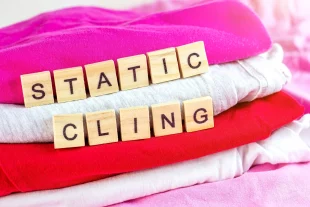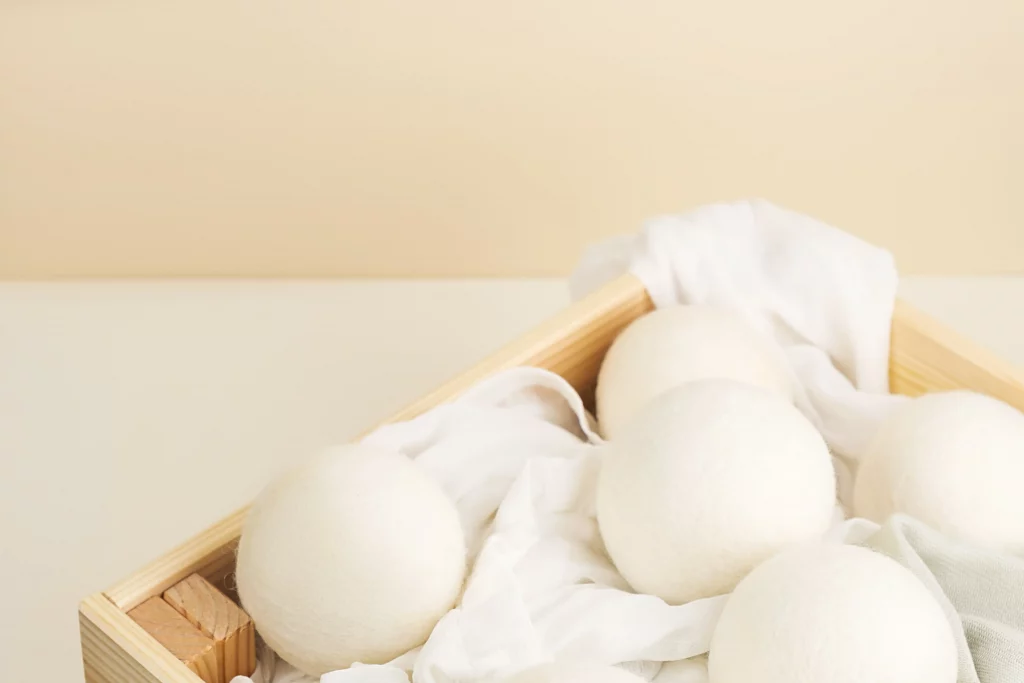 Get How-To's
Get How-To's
How to Get Rid of Static Cling
$3 Dry Cleaning Wednesday 1-4 PM with Coupon!
Read tips, tricks, and how-to’s on our Fabric of Life blog.
Garment Guides

Wool dryer balls are a laundry room necessity that works well on garments made of natural and synthetic materials. They are also known to be a gentle solution, unlike many leading dryer sheets and softeners that boast strong fragrances that can irritate sensitive skin.
If you are tired of spending money on traditional disposable dryer sheets and are looking for a reusable, affordable solution, wool dryer balls may be the answer. These small soft balls are made from felted wool and can be thrown in the dryer to replace fabric softener and dryer sheets. Their natural fibers absorb water from damp clothing, reducing drying times and minimizing static cling and agitation between clothes.
The first step to properly using wool dryer balls is to determine if your load size is small, medium, or on the larger side. Size determines how many wool balls you will need to successfully reduce friction. For a small dryer clothes load, 2-3 balls will do. However, for medium loads you may want to throw in about 3-4, and for large loads, 5-6 dryer balls. These figures ensure your wool dryer balls absorb enough excess moisture to effectively limit static, improve the drying process, and reduce drying time.
If you want to add a bit of fragrance to your laundry you can add a few essential oils to your dryer balls. Don’t overdo it. A couple of drops per ball will suffice—this infuses your clothes with a light scent without relying on synthetic fragrances.
By optimizing your use of wool dryer balls and incorporating essential oils, you can enjoy fresher, softer laundry while minimizing drying time—making laundry day a little more pleasant and efficient!
How wool balls reduce static cling is actually quite simple. A wool dryer ball works by absorbing the water from wet laundry. This helps balance the humidity levels in the dryer, reducing static cling. In addition to absorbing water, they also create space in between clothes. More space between garments resulting reduced friction also helping to minimize static cling charge and wear and tear. With less agitation and proper humidity levels, you can expect static-free, cling-free clothing after every dryer when you use a wool dryer ball.
We touched on this a bit already, but wool dryer balls save money when compared to traditional dryer sheets/softeners. This is because you can reuse them over and over again. Purchase them once and have them for thousands of loads.
More than reusability, dryer balls also save money by reducing drying times. As you already know, wool dryer balls work by absorbing water. This means clothes dry faster, saving you utility money and time. Who doesn’t love a lower electricity bill?
Wool dryer balls are better for the environment for one major reason: they are reusable! This means not only does using dryer balls save you money, but it is also saving the planet. Traditional fabric softeners and single-use dryer sheets create waste from boxes and plastic jugs to the dryer sheets themselves.
Some softeners and dryer sheets also contain harmful chemicals that can lead to damaged ecosystems as they seep into the ground and get into waterways. With wool dryer balls, you can rest assured your drying solution is environmentally friendly.
Unlike traditional methods which can have irritating ingredients, wool dryer balls are made of natural materials safe for sensitive skin. However, using dryer balls doesn’t mean you have to give up on the bonus of fragrance that comes with traditional methods. Remember, you can add skin-safe essential oils. Try lavender for a calming nature or lemon to invigorate your senses. Essential oils are great at adding light fragrances without irritating ingredients that can be harsh on sensitive skin.
While wool dryer balls are one of the most effective dryer balls, there are a few alternatives including plastic dryer balls, rubber dryer balls, and tennis balls. Let’s dive into the details of each of the alternatives:
Plastic dryer balls are good at separating clothes, which as we know, helps minimize agitation between clothes. However, they are not good at absorbing excess water, meaning they are less effective at eliminating static and wrinkles.
Another concern that comes with plastic dryer balls is chemical leaching as they are often made from PVC. While this issue has limited supporting evidence, some individuals prefer to play it better safe than sorry and opt for a natural alternative.
On a similar note, plastic balls are non-biodegradable, making them less environmentally friendly compared to wool balls. However, since we are comparing the two, we should note that plastic dryer balls are often less expensive than wool dryer balls. This makes them ideal for super-tight budgets.
Rubber dryer balls, like their plastic counterparts, excel at separating clothes in the dryer. This separation helps improve airflow, reduce drying time, and minimize wear and tear caused by clothes rubbing together. However, rubber dryer balls also fall short when it comes to absorbing moisture. This limits their ability to reduce static cling and wrinkles as effectively as alternatives like wool dryer balls.
One potential drawback of rubber dryer balls is their durability over time. While they are less prone to cracking than plastic balls, exposure to high heat and repeated use can eventually cause them to degrade or lose elasticity. Moreover, some rubber dryer balls may contain synthetic materials or additives that raise concerns for individuals seeking a more natural option.
Tennis balls are effective at fluffing laundry and improving airflow in the dryer, which can reduce drying time. However, they are not as efficient as purpose-made dryer balls at reducing wrinkles, static, or absorbing moisture.
In terms of safety, tennis balls are generally safe for use in the dryer. Yet some individuals may be concerned about the potential transfer of dyes or chemicals from the outer material onto clothing. This reigns especially true when drying light-colored clothing (It’s nothing a good wash couldn’t fix!).
Nevertheless, tennis balls are an extremely affordable option, particularly if you already have a few on hand. For those looking to save money, they can be a practical, budget-friendly alternative to dedicated dryer balls.
Overall, wool yarn dryer balls offer a natural alternative, while plastic and rubber balls raise environmental concerns. Ultimately, the best choice depends on personal preferences related to effectiveness, safety, and environmental impact. And if dryer balls aren’t for you, you can always opt for traditional dryer sheets or laundry softener.
Wool dryer balls are an eco-friendly alternative to traditional dryer sheets and laundry softeners, but caring for them is essential to ensuring they last for years to come. Typically, with proper use and care, wool dryer balls can live to see for 2-4 years.
To maintain their effectiveness, wash them occasionally by placing them in a pillowcase and running a gentle cycle with your laundry, avoiding high heat and hot water. If they lose their shape, you can reshape them using a felting needle to compact the fibers back into form.
Be sure to store your dryer balls in a dry place to prevent mold and avoid overloading the dryer, which can cause wear and tear. Signs that it’s time for replacement include visible wear like tearing or excessive fuzziness, diminished performance in reducing drying time, and a lack of bounce.
When you need to dispose of old dryer balls, consider eco-friendly methods. Wool is biodegradable, making it safe for composting. Alternatively, repurpose them as stuffing for crafts or cushions, giving them a second life. By following these maintenance tips and being mindful of replacement, you can ensure your wool dryer balls serve you well.
Wool dryer balls offer several advantages that significantly enhance the laundry drying process. They are designed to reduce drying time by promoting better air circulation in the dryer, which allows clothes to dry more evenly and quickly. They can also minimize static cling, leaving your clothing fresh and static-free by absorbing excess water from damp laundry. By incorporating eco-friendly practices, such as using wool dryer balls, you can also contribute to a more sustainable environment.
For more laundry help head over to CD One Price Cleaners. We provide reliable laundry services and solutions to help you maintain the quality of your favorite articles of clothing. From everyday clothing to special items, you can trust us to handle your laundry needs with professionalism and care.